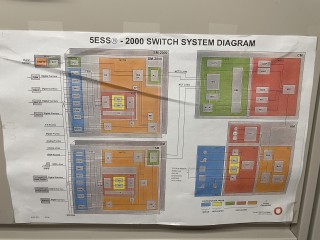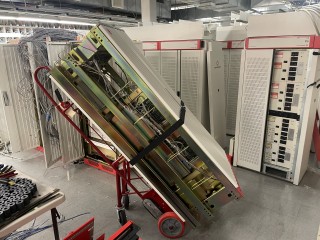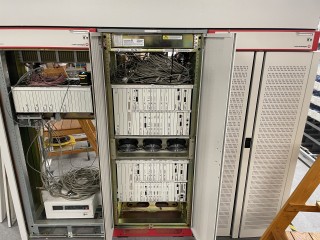I am still recovering from the fairly challenging logistical project of saving a
Lucent 5ESS. This is a whale of a project and I am still in a state of disbelief
that I have gotten to this point. Thanks to my wife, brother, and a few friends
for their help and the University of Arizona which has a very dedicated and
professional Information Technology Services staff.
It started when I saw some telephone history enthusiasts post about a
construction bid at the University of Arizona. It turns out, U of A installed
the 5ESS in the late 1980s in a rather forward thinking move that netted a phone
system that handled the growth of the University, medium speed data anywhere a
phone may be located (ISDN BRI or PRI), and copper and fiber plant that will
continue to be used indefinitely.
At peak, it served over 20,000 lines. They’ve done their own writeup, The End
of An Era in Telecommunications, that is worth a read. In particular, the
machine had an uptime of approximately 35 years including two significant
retrofits to newer technology culminating in the current Lucent-dressed 7 R/E
configuration that includes an optical packet-switched core called the
Communications Module 3 (CM3) or Global Messaging Server 3 (GMS3).

Moving 40 frames of equipment, this required a ton of planning and muscle. The
whole package took up two 26′ straight-trucks, which is just 1′ short of an
entire standard US semi-trailer.
Coming from the computing and data networking world, the construction of the
switch was quite bewildering at first. It is physically made up of standard
frames which are interconnected into rows not unlike datacenter equipment, but
the frames are integrated into an overhead system for cable management.
Internally, they are wired up usually within the row and quite a few cables
route horizontally beween frames, but some connections have to transit up and
over to other rows.
Line Trunk Peripherals hook up to a Switching Module Controller (SMC) directly
or an OXU (Optical Cross Connect Unit) which hooks up to an SMC and reduces the
amount of copper cabling going between rows. Alarm cables run directly to an OAU
(Office Alarm Unit) or form rings in between rows that eventually end at the
OAU. Optical connections go from OXUs to SMCs and then to the CM, copper test
circuits home run to a Metallic Test Service Unit shelf. Communications Cables
come out the top and route toward the wire frame, usually in large 128 wire
cables but occasionally in smaller quantity for direct or cross connect of
special services. A pair of Power Distribution Frames distribute -48V throughout
the entire footprint, taking into account redundancy at every level.
All of this was neatly cable laced with wax string. Moving a single frame
required hundreds of distinct actions that vary from quick, like cutting cable
lace, to time consuming removal of copper connections and bolts in all
directions.

We were able to complete the removal in a single five day workweek, and I was
able to unload it to my receiving area in two days over the weekend where it now
safely resides.
The next step will be to acquire some AC and DC power distribution equipment,
which will have to wait for my funds to recover.
I should be able to boot the Administrative Module (AM), a 3B21D computer, up
relatively soon by acquiring a smaller DC rectifier and that alone will be very
interesting as it is the only use I know of the DMERT or UNIX-RTR operating
system, a fault tolerant micro-kernel realtime UNIX from Bell Labs.

The system came with a full set of manuals and schematics which will help
greatly in rewiring and reconfiguring the machine. After the AM is up, I need to
“de-grow” the disconnected equipment and I will eventually add back in an
assortment of line, packet, and service units so that I can demonstrate POTS as
well as ISDN voice and data. In particular, I am looking forward to
interoperating with other communication and computing equipment I have.
I will have to reduce the size of the system quite a bit for power and space
reasons so will have spare parts to sell or trade.
Additional Pictures are available here until I have a longer term project page
established.
This is too much machine for one man, and it is part of a broader project I am
working on to build a computing and telecommunications museum. If you are
interested in working on the system with me, please feel free to reach out.

